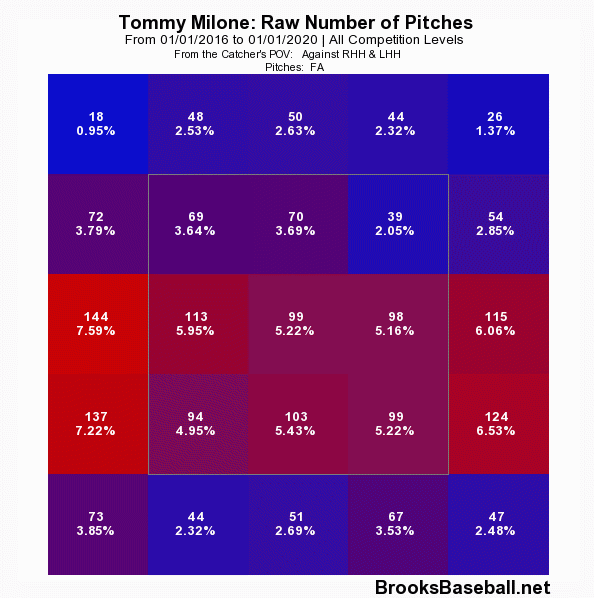I’ll be honest, I can’t say I ever thought that I’d be writing an article about Tommy Milone, but the more I’ve looked into him, the more it feels like he’s just inches away from being a solid starting pitcher, which would make him an interesting pitcher for fantasy baseball.
I want to preface this by telling you what I am not saying. I’m not saying you should draft Tommy Milone. I’m not saying Tommy Milone definitely will become a good pitcher, nor am I suggesting Tommy Milone is some kind of unheralded fantasy sleeper.
What I am saying is that I think you should be aware of Milone, file his name in the back of your mind and keep an eye on him. I think he has a lot more to like about him than you might think at first glance, and I think that with a bit of tweaking, he could be a pretty usable starter.
The Good
You might not think there’s really anything to like about Milone looking at his numbers. Last year, in 111.2 innings, he posted a 4.76 ERA, 5.00 FIP, and 4.30 SIERA. But he also posted a career-best 20.8% strikeout rate, and there’s a good reason for that—his changeup.
https://gfycat.com/mildvaguefawn
Last year, Milone turned his changeup into an excellent strikeout pitch. How excellent? The pitch had the third-highest chase rate in all of baseball (min. 200 pitches, so essentially starters) at 52.4%. The only pitches that had higher chase rates in the entire MLB were Justin Verlander’s slider and Hyun-Jin Ryu’s changeup.
It gets better—the pitch also had a 17.6% SwStr rate, 24.6% CSW, .232 wOBA against, and .121 ISO against, all adding up to a 12.2 pVAL. In short—Tommy Milone now has an elite strikeout pitch. It wasn’t a money pitch since it had a 27.5% zone rate, but when you’re getting that absurd of a chase rate, who cares?
So what happened? Where did this come from? It’s pretty clear that Milone made some adjustments to the pitch, making it so the pitch doesn’t have much vertical movement to it (it had 3.3 inches of drop on it last year, the least amount of vertical movement it’s ever had) and adding some horizontal movement to it. It’s also worth noting the pitch has more spin on it than it ever has before (or, at least, since Statcast started tracking spin rates).
All of that is to say, Milone’s changeup is a different pitch, and it’s a really really good pitch. But one excellent pitch doesn’t make a starting pitcher, it maybe makes a good reliever. Fortunately, Milone has another breaking pitch that works fairly decently—his slider.
https://gfycat.com/milkywhisperedgerenuk
Milone’s slider isn’t an incredible pitch, but it’s perfectly solid. It’s not a big strikeout pitch, with a 33.6% chase rate and 9.6% SwStr rate last year (though those are fine numbers).
However, the pitch does induce weak contact, posting a 43.6% groundball rate, .274 wOBA against, and .154 ISO against. Again, not mind-bending stuff, but a pitch that is useful in a repertoire.
More broadly than just his raw stuff, Milone is quite good at commanding the strike zone. Last year, threw 46.9% of his pitches on the edge of the zone, above the league average of 39%, and he posted a 5.1% walk rate, good for 15th-best in the MLB among pitchers with at least 100 innings pitched.
So what do we look for in a “good” pitcher? Well in Milone, we’ve got a guy who commands the strike zone well, has an elite-strikeout pitch, and another breaking pitch that’s solid. But Milone generally throws three pitches, and that third pitch is where things get dicey.
Tommy Milone’s Terrible, Horrible, No Good, Very Bad Fastball
There is one glaring, gross, awful, disgusting problem with Tommy Milone—his fastball. It’s really bad.
Name a metric, his fastball is terrible in it. The pitch tops out at around 89 MPH and averages 87 MPH. Last year, opposing hitters had a .384 wOBA against it, as well as a .258 ISO. And it wasn’t just last year—this pitch has been bad for a while now. In fact, in Milone’s entire career the pitch has never posted a positive pVAL, with its best pVAL coming in his rookie year in 2011 at -1.8, followed by the -3.0 it posted in 2018.
For his career, which spans nine seasons and 874.2 innings pitched, opposing hitters have a .382 wOBA and a .257 ISO against Milone’s fastball. And yet, it continues to be his most-thrown pitch, year-in and year-out.
Why is it so bad? I think it’s a combination of two things: one, obviously an 87 MPH fastball is almost a batting practice fastball in the MLB today. Second, his location isn’t ideal:

And what happens when you throw a sub-90 MPH fastball right around the middle-area of the plate? A lot of this:
https://gfycat.com/someperfectleonberger
Why you should bother paying attention to Tommy Milone
So we’ve established that Milone has good command of the strike zone, an elite strikeout pitch in his changeup, a solid breaker in his slider, and a godawful fastball, which pretty much equals an incomplete pitcher who should post numbers like Milone has been posting. So why should you bother paying attention to him at all? Because he has one, specific problem, and I think that problem can be addressed in at least one of two ways.
First, the most obvious one, is he elevates his fastball more. Now, that might not work out so hot given that, again, he averages about 87 MPH on the pitch. But if there’s one thing recent pitching analytics (and working here with Nick) has taught me, it’s that it’s best to elevate fastballs and throw your breakers low—change the hitter’s eye level.
Another potential and probably more realistic solution would be for him to change his pitch mix and all but abandon his four-seam fastball. Does that mean he just throws more changeups and sliders without throwing his fastball much? No, I don’t think that’s going to be effective (though dialing up the breakers a bit might still help).
Instead, I’d like to point to another pitcher as an example of what Milone could do—Martin Perez. Before last year, Perez was not a particularly good pitcher, but for a good stretch of the season last year, he was quite good, and that was thanks to a brand new pitch he started throwing—a cut fastball. That pitch became his most-thrown pitch, and it’s an excellent pitch, the best cutter in baseball last year by pVAL, despite averaging just around 88 MPH. Now, Perez has basically nothing else but his cutter, which is why he’s still an above-5.00 ERA pitcher, but that’s not the case for Milone.
Milone used to throw a cutter, and it was a fairly serviceable pitch. Back in 2015, Milone threw his cutter 200 times and hitters had just a .288 wOBA and .151 ISO against it. Plus, it garnered a solid 31.6% chase rate.
Since then Milone hasn’t really thrown it much, throwing it just 82 times in 2016, 26 times in 2017, and 18 times in 2018 (he didn’t throw it at all last year). On his career, though, the pitch has a .303 wOBA and .136 ISO against in over 1,000 pitches. Imagine Milone dials his four-seamer way down, brings the cutter back, and it’s at least an average to slightly-above-average pitch? Then all of a sudden, his repertoire is looking a lot better (plus, it’s worth noting, you can generally get away with a cutter that’s under 90 MPH, not so much with a four-seamer).
But the key to all of this is opportunity. Luckily for Milone, he signed a deal with the Baltimore Orioles, an organization that has absolutely no reason not to grab cheap veterans, try and fool around with them, and give them time to pitch. Plus, the Orioles’ rotation is hardly set in stone. I mean, are we really sold on Wade LeBlanc and Kohl Stewart sticking in the rotation the whole season over someone like Milone?
Plus, the Orioles are now a lot more analytics-focused with the new regime in place. Guys like GM Mike Elias and assistant GM Sig Mejdal made careers of out-developing other teams and tweaking fringe pitchers to turn another team’s trash into gold (see: Charlie Morton, Ryan Pressly). Could Tommy Milone be another project for them? Why not?
Photo by Cliff Welch/Icon Sportswire | Adapted by Justin Paradis (@freshmeatcomm on Twitter)

